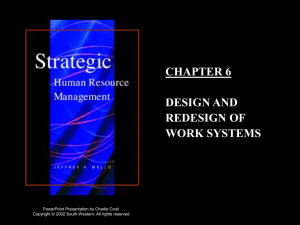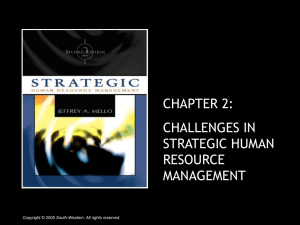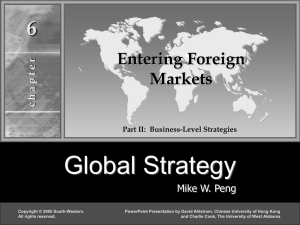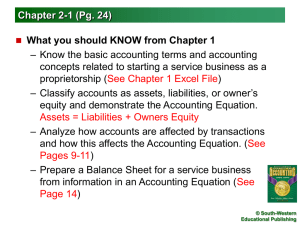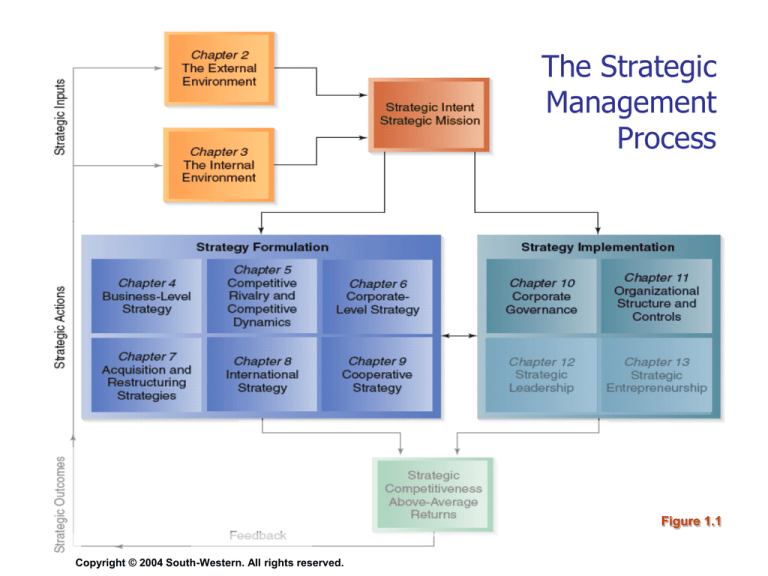
The Strategic
Management
Process
Figure 1.1
Copyright © 2004 South-Western. All rights reserved.
Copyright © 2004 South-Western. All rights reserved.
11–1
Chapter 11: Organizational Structure
(and Controls)
• Components of internal strategic fit
• Role of organizational structure in strategy
implementation
• Basic forms of organizational structure;
advantages/disadvantages of each
- simple
- functional
- multi-divisional (M-Form) - 3 types
Copyright © 2004 South-Western. All rights reserved.
11–2
Chapter 11: Organizational Structure
(and Control)
• Strategic control; financial control
• Strategy-structure “fit”
• Contemporary forms of organizational
structure
- matrix structure
- strategic alliances, networks, virtual
organizations (Chapter 9)
- creative/experimental forms
Copyright © 2004 South-Western. All rights reserved.
11–3
Components of Internal Strategic Fit
(Froelich Model)
Environment
Strategy
Structure
Systems
Resources/Capabilities
Organizational Culture
Copyright © 2004 South-Western. All rights reserved.
11–4
Organizational Structure
• Organizational structure specifies:
The firm’s formal reporting relationships,
procedures, controls, and authority and
decision-making processes
• It is critical to match organizational
structure to the firm’s strategy
Copyright © 2004 South-Western. All rights reserved.
11–5
Organization structure - Why so important?
• Bounds day-to-day behaviors; it directs
daily actions of individuals and groups
• Includes authority relationships, which are
huge influences on workplace behaviors
• Has resource allocation and control
implications
• Involves pragmatic operational issues
related to efficiency and effectiveness
• Structural decisions are more common than
strategic decisions
• Structure expertise is undeveloped
Copyright © 2004 South-Western. All rights reserved.
11–6
Relationships between Strategy and
Structure
• Strategy and structure have a reciprocal
relationship:
Structure flows from or follows the selection of
the firm’s strategy
but …
Once in place, structure can influence current
strategic actions as well as choices about future
strategies
Copyright © 2004 South-Western. All rights reserved.
11–7
Strategy and Structure
Growth Pattern
Efficient implementation
of formulated strategy
• As firms grow larger and
become more complex,
structural challenges
emerge
• Firms’ larger sizes dictate
the need for more
sophisticated workflows and
integrating mechanisms
Simple
Functional
Efficient implementation
of formulated strategy
Multidivisional
Figure 11.1
Copyright © 2004 South-Western. All rights reserved.
11–8
Strategy and Structure: Simple Structure
• Owner-manager
Makes all major decisions directly
Monitors all activities
• Staff
An extension of manager’s supervisor authority
• Matched with focus (or niche) strategies and
small single business strategies
Commonly compete by offering a single product
line in a single geographic market
Copyright © 2004 South-Western. All rights reserved.
11–9
Simple Structure (cont’d)
Advantages?
Copyright © 2004 South-Western. All rights reserved.
Disadvantages?
11–10
Strategy and Structure: Functional Structure
• Chief Executive Officer (CEO)
Limited corporate staff
• Functional line managers in needed
organizational areas, possibly:
Manufacturing Marketing
Accounting
R&D
Engineering
HRM
• Supports use of business-level strategies
and some corporate-level strategies
(larger) Single or dominant business with low
levels of diversification
Facilitates centralization/company-wide
coordination
Copyright © 2004 South-Western. All rights reserved.
11–11
Functional Structure for Implementation of
a Differentiation Strategy
Notes:• Marketing is the main function for keeping track of new product ideas
• New product R&D is emphasized
• Most functions are decentralized, but R&D and marketing may have centralized staffs that work closely with each other
• Formalization is limited so that new product ideas can emerge easily and change is more readily accomplished
• Overall structure is organic; job roles are less structured
Figure
Copyright © 2004 South-Western. All rights reserved.
11.3
11–12
Functional Structure under
a Differentiation Strategy
• Marketing is the main function for tracking
new product ideas
New product R&D is emphasized
Most functions are decentralized
Formalization is limited to foster change and
promote new ideas
Overall structure is organic
Job roles are less structured
Copyright © 2004 South-Western. All rights reserved.
11–13
Functional Structure for Cost Leadership Strategy
Notes: • Operations is the main function
• Process engineering is emphasized rather than new product R&D
• Relatively large centralized staff coordinates functions
• Formalized procedures allow for emergence of a low-cost culture
• Overall structure is mechanical; job roles are highly structured
Copyright © 2004 South-Western. All rights reserved.
Figure 11.2
11–14
Functional Structure under
a Cost Leadership Strategy
• Operations is typically the main function
Process engineering is emphasized over
research and development
Large centralized staff oversees activities
Formalized procedures guide actions
Structure is mechanical
Job roles are highly structured
Copyright © 2004 South-Western. All rights reserved.
11–15
Implementing an Integrated Cost
Leadership/Differentiation Strategy
• The integrated form of the functional
structure must have:
Decision-making patterns that are partially
centralized and partially decentralized
Semi-specialized jobs
Rules and procedures that allow both formal and
informal job behaviors
A hybrid form; no wonder it is hard to implement!
Copyright © 2004 South-Western. All rights reserved.
11–16
Functional Structure (cont’d)
• Differences in orientation among
organizational functions can:
Impede communication and coordination
Cause functional-area managers to focus on
local versus overall company strategic issues
Increase the need for CEO to integrate decisions
and actions of business functions
Facilitate career paths and professional
development in specialized functional areas
Copyright © 2004 South-Western. All rights reserved.
11–17
Evolutionary Growth of the Firm
leading to increased diversification
• A firm’s continuing success that leads to:
Product diversification, or
Market diversification, or
Both product and market diversification
• Increasing diversification creates
information processing and coordination
problems that the functional structure can’t
handle
Copyright © 2004 South-Western. All rights reserved.
11–18
Strategy and Structure:
Multidivisional Structure
• Top corporate officer delegates
responsibilities to division managers
For day-to-day operations
For business-unit strategy
• Appropriate as a firm grows through
diversification
Copyright © 2004 South-Western. All rights reserved.
11–19
Example of M-Form Structure
Diageo, PLC
Premium
Drinks
Quick Service
Restaurants
Copyright © 2004 South-Western. All rights reserved.
Processed
Food
11–20
Multidivisional Structure (cont’d)
• Major Benefits
Corporate officers are more detached as they
monitor and compare performance of divisions,
facilitating resource allocation decisions
Stimulates divisional managers to optimize
performance of their units
Provides for faster reaction to change and a
stronger customer focus at division level
Development of “general management” expertise
within the firm
Copyright © 2004 South-Western. All rights reserved.
11–21
Multidivisional Structure (con’t)
• Major Disadvantages
Increased complexity of the firm overall
Difficulties coordinating and sharing expertise
across divisions
Duplication of resources
Tendency to rely on financial controls rather than
strategic controls
Copyright © 2004 South-Western. All rights reserved.
11–22
Organizational Controls
Strategic
Controls
Organizational
Controls
• “Subjective” (strategically relevant) Criteria
Philosophy of the “balanced scorecard”
Evaluate the degree to which the firm
accomplishes key tasks related to success of the
particular strategy being implemented
Examples = market share, innovation lead time,
image, location advantages, product mix
requires in-depth knowledge/insight in market
Copyright © 2004 South-Western. All rights reserved.
11–23
Organizational Controls
Strategic
Controls
Organizational
Controls
Financial
Controls
• “Objective” financial criteria
Enables comparisons of differing divisions using
“standardized financial measures, such as:
. . . . . .
Requires less strategic understanding
Use with caution - do not tell the whole story!
Copyright © 2004 South-Western. All rights reserved.
11–24
Matching Control to Strategy
• Relative use of controls varies by type of
strategy
Large diversified firms using a cost leadership
strategy tend to emphasize financial controls
Companies and business units using a
differentiation strategy typically emphasize
strategic controls
Copyright © 2004 South-Western. All rights reserved.
11–25
Corporate-Level Strategies and the
Multidivisional Structure (cont’d)
• Diversification strategy requires firm to
change from functional structure to a
multidivisional structure
• Different levels of diversification create the
need for implementation of a unique form of
the multidivisional structure
Copyright © 2004 South-Western. All rights reserved.
11–26
Variations of the Multidivisional Structure
Figure 11.4
Copyright © 2004 South-Western. All rights reserved.
11–27
Cooperative Form of Multidivisional Structure: Related-Constrained Strategy
Notes • Structural integration devices create tight links among all divisions
• Corporate office emphasizes centralized strategic planning, human
resources, and marketing to foster cooperation between divisions
• R&D is likely to be centralized•
Copyright © 2004 South-Western. All rights reserved.
• Rewards are subjective and tend to emphasize overall corporate
performance in addition to divisional performance
• Culture emphasizes cooperative sharing
Figure 11.5
11–28
Multidivisional Structure: Cooperative Form
• Development of integrating mechanisms to
bring about cooperation among divisions
• Goals = activity sharing/skill transfer
• HQ involved in centralized strategic
planning, HRM, marketing, and possibly
other functions with synergistic potential
• R&D is likely centralized
• Greater use of strategic control measures
Related-Constrained Strategy
Copyright © 2004 South-Western. All rights reserved.
11–29
Cooperative Form (cont’d)
• Rewards consider overall corporate
performance in addition to division
performance
• A more cooperative culture is nurtured
• A more complex management task
compared to the competitive M-Form
• Companies need to better figure
out/understand how to do this!
Related-Constrained Strategy
Copyright © 2004 South-Western. All rights reserved.
11–30
Competitive Form of Multidivisional Structure:
Unrelated Strategy
Notes • Corporate headquarters has a small staff
• Finance and auditing are the most prominent functions
in the headquarters office to manage cash flow and
assure the accuracy of performance data coming from
divisions
• The legal affairs function becomes important when the firm acquires or
divests assets
• Divisions are independent and separate for financial evaluation purposes
• Divisions retain strategic control, but cash is managed by the corporate office
• Divisions compete for corporate resources
Figure 11.7
Copyright © 2004 South-Western. All rights reserved.
11–31
Multidivisional Structure: Competitive Form
• A structure in which there is independence
among the firm’s divisions
Divisions do not share common strengths, so
integrating mechanisms are not employed
Corporate HQ has a small staff; strategy is
delegated to divisions, but resource allocation
among divisions is centralized
Financial controls predominate
Prominent functions are finance, auditing; plus
legal is acquisitions/divestitures are frequent
Culture of competition rather than cooperation
between divisions
Unrelated Strategy
Copyright © 2004 South-Western. All rights reserved.
11–32
Even More Structures !!!
• Structures for international strategies
• (Network) structures for cooperative
strategies
• Matrix structures to facilitate innovation
• Creative and experimental structures
Copyright © 2004 South-Western. All rights reserved.
11–33
Worldwide Geographic Area Structure:
Multi-domestic Strategy
Notes: • The perimeter circles indicate decentralization of
operations
• Emphasis is on differentiation by local demand to fit
an area or country culture
• Corporate headquarters coordinates financial
resources among independent subsidiaries
• The organization is like a decentralized federation
Copyright © 2004 South-Western. All rights reserved.
Figure 11.8
11–34
Worldwide Product Divisional Structure:
Global Strategy
Notes • The headquarters’ circle indicates centralization to
coordinate information flow among worldwide products
• Corporate headquarters uses many intercoordination
devices to facilitate global economies of scale and scope
• Corporate headquarters also allocates financial resources
in a cooperative way
• The organization is like a centralized federation
Copyright © 2004 South-Western. All rights reserved.
Figure 11.9
11–35
Matrix Organizational Form
• Simultaneous use of functional departments
and project teams
• To facilitate and speed strategies relying on
innovation
• Seldom used for structuring an entire
organization; rather, used in particular areas
of the organization as needed
Copyright © 2004 South-Western. All rights reserved.
11–36
Matrix Structure
Advantages
Copyright © 2004 South-Western. All rights reserved.
Disadvantages
11–37
Creative/Experimental Structural Forms . . .
• “Organizational ecosystem” concept of
overlapping teams - to facilitate innovation
and high employee commitment
• Bottom-up structures - to emphasize
importance of customers and staff
• Non-hierarchical structures - to focus on
organizational mission/shared values
•.....
Copyright © 2004 South-Western. All rights reserved.
11–38
Creative and Experimental Structures,(con’t)
• think about - is the new structure really
cutting edge, or merely a wasteful fad?
• BEWARE of the “latest and greatest”
consultant’s products!
• be pragmatic - does the structure fit your strategy?
- are employee relationships clear and
workable?
- is the structure adequately efficient?
Copyright © 2004 South-Western. All rights reserved.
11–39
A Strategic Network - for elaborate
cooperative strategies (Chapter 9)
Strategic
Center
Firm
Adapted from
Figure 11.10
Copyright © 2004 South-Western. All rights reserved.
11–40
Strategic Center Firm
• Is the foundation for the strategic network’s
structure
Manages the complex, cooperative interactions
among network partners
• Is more obvious in stable and vertically
arranged networks, but less obvious in
horizontally arranged and dynamic networks
Copyright © 2004 South-Western. All rights reserved.
11–41
The “best” organizational structure =
Copyright © 2004 South-Western. All rights reserved.
11–42
Conclusions about organizational structure:
•
• Structure must facilitate the necessary tasks
to accomplish the organization’s strategy.
• Structure is a major “ingredient” in
successful strategy implementation.
• Change in strategy requires change in
structure
Copyright © 2004 South-Western. All rights reserved.
11–43

